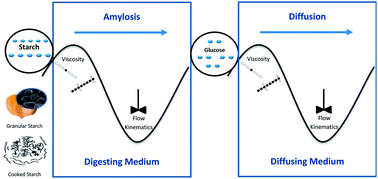Enzymatic hydrolysis of starch in the presence of cereal soluble fibre polysaccharides†
Abstract
The in vitro amylolysis of both granular and cooked maize starch and the diffusion of glucose in the presence of 1% and 2% cereal soluble fibre polysaccharides (arabinoxylan and mixed linkage beta-glucan) were studied at various levels of shear mixing in order to identify potential molecular mechanisms underlying observed glycemia-reducing effects of soluble fibres in vivo. The presence of soluble fibres increased viscosity by ca. 10× and 100× for 1% and 2% concentrations respectively. Despite this large difference in viscosity, measured digestion and mass transfer coefficients were only reduced by a factor of 1.5 to 2.5 at the same mixing speed. In contrast, introduction of mixing in the digesting and diffusing medium significantly increased the rate of amylolytic starch digestion and mass transfer of glucose. This effect is such that mixing at high speeds negates the hindering effect of the 100× increased viscosity imparted by the presence of 2% soluble fibre; this is essentially captured by the Reynolds number (the ratio of inertial and viscous forces) that defines the flow kinematics. The modest reduction of in vitro starch hydrolysis and glucose diffusion at increased viscosity suggests that the established benefits of soluble fibres on post-prandial glycaemia, in terms of attenuation of the overall rate and extent of dietary starch conversion to blood glucose, are not primarily due to a direct effect of viscosity. Alternative hypotheses are proposed based on gastric emptying, restriction of turbulent flow, and/or stimulation of mucus turnover.


 Please wait while we load your content...
Please wait while we load your content...